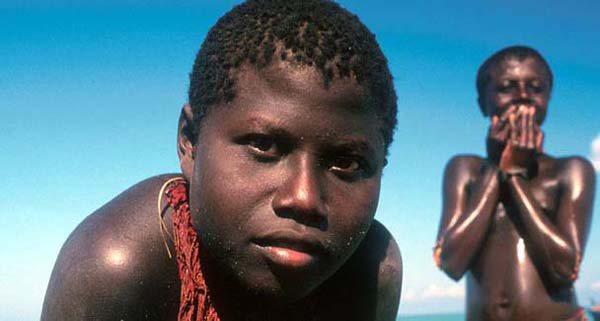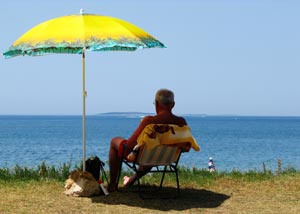1. Select only ONE of the following
environmental stresses:
(a) heat,
(b) high levels of solar radiation, (c) cold, or (d) high altitude.
Discuss specifically
how this environmental stress negatively impacts the survival of humans by
disturbing homeostasis.(5 pts)
Out
of the four options of environmental stresses to choose from, I chose high
levels of solar radiation. High levels of solar radiation negatively impacts
the survival of humans by disturbing homeostasis because they affect the Melanin which is located in
the epidermis.
2. Identify
4 ways in which humans have adapted to this stress, choosing one specific adaptation
from each of the different types of adaptations listed above (short term,
facultative, developmental and cultural). Include images of the adaptations.(5
pts each/ 20 pts total)
I don’t
believe humans have no short term adaptions from high levels of radiation. The only
thing I can think of is when a human stays out of the sun to avoid the sun which produces the radiation.

A
facultative adaption would be the tanning of skin. In the summer people tend to
be darker, and in the winter they tend to lose this “color”. This is because of
environmental stress. In the summer time humans expose themselves to more
radiation than they do in the winter, due to the fact that individuals are
exposing themselves more in the summer their bodies produce a natural sunscreen
which protects us until the environmental stressor goes away. This explains why
we tend to be darker in the summer and lighter in the winter.
Developments
adaptions would be found in darker populations. Individuals who live where they
are exposed to higher rays, need the dark skin. The individuals with darker
skin can tolerate higher levels of radiation better.

Cultural
adaptions would be the clothing we wear, the sunscreen we put on, and the items
we made to protect ourselves from the radiation. We have developed clothing
which can block the rays from reaching our skin. We have developed sunscreen to
be able to go into the sun with protection. Last but not least we have
developed items to block the radiation such as umbrellas.



3. What
are the benefits of studying human variation from this perspective across
environmental clines? Can information from explorations like this be useful to
help us in any way? Offer one example of how this information can be used in a
productive way. (5 pts)
Some
benefits would be that we can learn where we have come from and how much we
have adapted. Humans live all over the world and we can see why individuals who
live by the beach are darker than the people who live in Alaska, and what the
actual purpose of being “tan” is. Yes this information can be helpful to us,
one example would be vitamin D and skin cancer. This information is good to
know because we can determine how much radiation is good because humans need
vitamin D, however too much can be cancerous and can lead to death.

4. How
would you use race to understand the variation of the adaptations you listed in
#2? Explain why the study of environmental influences on adaptations is a
better way to understand human variation than by the use of race.
(10pts)
Race
could be used to understand the variation of adaptions listed in #2 because of
the skin color. Skin color is a form of adaption, individuals with darker skin
can withstand more radiation therefore we can determine they live or lived
somewhere with high levels of radiation. The study of environmental influences
on adaptions is a better way to understand human variation because the color of
our skin is adaption to an environmental stressor rather than a form of inferiority.
Each human is different and just as pbs.org stated, “not one characteristic,
trait or gene distinguishes all members of one so called from all members of
another so called race.”

"...they affect the Melanin which is located in the epidermis."
ReplyDeleteThis is very vague. How does it "affect" the melanin and why is that harmful to humans?
Correct, there is no short term adaptation to solar radiation. That is why this stress is so dangerous.
It's true that we tend to get more sun exposure on a seasonal basis, but it isn't just behavior. During our summer months, the sun is more directly overhead, meaning that the radiation intensity is also higher (along with the heat index). Otherwise, good description.
Your developmental discussion explains why people nearer the equator have darker skin. But why do people farther from the equator have lighter skin? Why not just keep the dark skin for protection? What is the advantage of lighter skin?
Good explanation on cultural adaptations.
"Race could be used to understand the variation of adaptions listed in #2 because of the skin color."
You say this but then you go on to explain the skin color based upon adaptive benefits. How are you using race? Is there any real benefit to using race to study human variation? How is race defined? Biologically? Or socially? Is it objectively defined or subjectively?
Hello Angelica:
ReplyDeleteI like your blog covering the effects of solar radiation. I thought the topic uninteresting at first, until I read your blog. In addition to disturbing homeostasis solar radiation research shows us it develops skin melanoma, the number one skin cancer. I would have to agree with you there is no human short term response to solar radiation. Being a “sun-worshipper” used to be the in-thing to do. Nowadays the taboo associated with solar radiation is a clear and present danger. My father had skin melanoma and it was the result of hanging his arm out the driver’s window of his vehicle for 30 years. Other than SPF 30 or better, sunscreen is the only option I know of to keep the sun’s rays to a minimum; and there is a great deal of dispute of beneficial effects from the usage of sunscreen. I would love to know where I could get some of that clothing, you mentioned that actually blocks solar radiation. My favorite concept you mentioned would be utilizing big umbrellas to avoid the harmful effects. PBS.org also provided me a fair amount of information to go on, aren’t they the most informative? More to the point, there is no trait, no gene, no one thing that distinguishes each individual and collectively as a unit.
Good job.
Debbie G.
Hello Angelica,
ReplyDeleteI enjoyed reading your post appreciated the information you provided. The only thing is I did not understand your response to question one. I would of preferred something with more details so I could better understand. Overall great job. I enjoyed seeing something different and something I did not know about. Enjoy your summer!